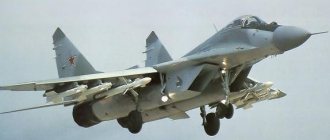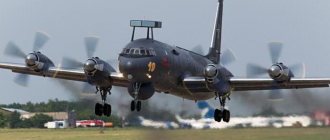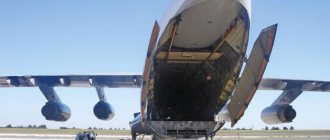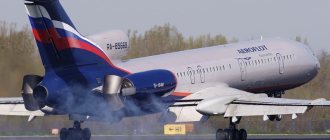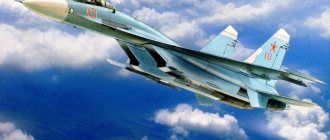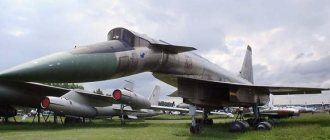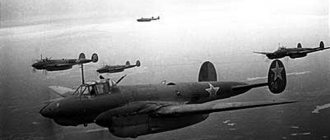The MiG-29 fighter is and remains one of the most common modern combat aircraft in the world. The MiG-29 has a long history. Over the years of production, 1,600 MiG-29s were produced. Today, the Russian Air Force operates approximately 270 fighters, and the Russian Navy has an additional 40 fighters. The MiG-29 fighter has been in service with both our former allies and NATO countries. The MiG-29 fighter sold quite well abroad.
The MiG-29 fighter is undoubtedly one of the most successful fighters of the USSR. The uniqueness of the aircraft lies in the fact that it demonstrated unique technical characteristics. It could fly at high angles of attack. To sharply go up or hit a missile, the pilot could pull the control levers beyond the limiters, which was inaccessible to Western analogues of the fighter. The history of the birth and adoption of the aircraft was long.
History of the creation of the MiG-29 fighter
Military aviation equipment in the USSR was created in parallel with new developments by NATO. The Soviet Union, looking back at the achievements in the field of military aircraft industry of the United States, Germany, and France, tried to keep up. Design bureaus of Sukhoi, Mikoyan, Gurevich, Yakovlev constantly worked to create aircraft capable of surpassing NATO technology.
The design of the MiG-29 aircraft began back in 1969. The USSR Air Force required a promising fighter (PFI) with an increased range, excellent maneuverability, and a speed above 2 M. The machine was supposed to lift heavy weapons into the sky. The new aircraft was supposed to be used on short runways. The PFI project was quite expensive. It was decided to produce light and heavy aircraft separately. The MiG-29 belonged to the light class. Its design has been carried out since 1974 by the Mikoyan Design Bureau.
The fighter made its first flight in 1977. Serial production began in 1982. The delay in production occurred due to the fact that the first aircraft had many defects, and two aircraft crashed during testing. MiGs were produced by Moscow Aviation. In 1983, the vehicles were sent to the Kubinka airbase for service. After successful testing of the MiG-29 at the Flight Research Institute. M. M. Gromov aircraft were sent to the First Fighter Aviation Regiment near Ivano-Frankivsk.
This development had many modifications. Some models were exported. Additionally, a carrier-based and training MiG-29 was created. Aircraft were produced at MAPO named after. Dementyev and at the aircraft plant in Nizhny Novgorod. Nowadays, the improvement and production of fighters is carried out in the Moscow region at the MiG RSK in Lukhovitsy. Since 1982, 1,600 units of equipment have been manufactured. There are about 270 MiG-29 aircraft in the Russian Air Force fleet.
Jet Age
An unpleasant surprise for American pilots was the MiG-15, which in terms of speed and maneuverability characteristics was superior to the vaunted products of Northrop and other US manufacturers, who considered their equipment unsurpassed. In the skies of warring Vietnam, the MiG-17 and MiG-21 interceptors performed excellently. There were other aircraft models, MiG-19 and MiG-23. During Israel's war with Egypt, the super-powerful MiG-25 repeatedly violated the front line, conducting raids over Tel Aviv. And although it did not carry any weapons, the very fact of the unpunished flight of a Soviet plane over a country armed with the latest American air defense systems cooled many hotheads. A number of regional conflicts, in which Soviet MiG military aircraft showed their best side, became a kind of advertisement for this brand, a guarantee of the quality and highest efficiency of Soviet military equipment. The crowning achievement of the designers' efforts was the MiG-29. Even today, 37 years after the completion of the main design work, the technical characteristics of this fighter fully meet the modern requirements for combat vehicles of this class.
Features and Benefits
The MiG-29 can reach speeds of up to 2,450 km/h and rise into the sky to a height of 18 km. The plane has two engines, but can only take off on one. Directly in flight, starting the second engine.
Performing a bell aerobatics maneuver, the plane takes off sharply vertically upward, and then freezes and quickly falls down, while the fighter disappears from the radar field of view for some time. Ace pilots can perform other aerobatic maneuvers on the MiG-29: “pyramid”, “hammer”, “cross”, “arrow”, “star”.
Aerobatic figure "bell"
The aircraft has innovations in the fuselage, due to which its aerodynamic characteristics have improved compared to earlier models. The body was made of aluminum and lithium alloys, and riveted joints were replaced with welded seams. The weight of the car has become less.
The housing is made of materials that absorb radio waves. The plane became less noticeable on radar. The MiG designers designed the wings sharper, thereby improving the quality of control of the aircraft even at high speeds.
The aircraft is equipped with rockets, bombs, and a cannon. The aircraft can accompany heavy bombers and cover them from enemy fighters. The light MiG is capable of flying reconnaissance missions. The fighter's armament is designed to intercept air targets, counter enemy reconnaissance assets, and destroy enemy aircraft.
Another development that provides the MiG-29 pilot with a clear advantage in combat is a helmet with a monocular sight. The pilot can catch a target and fire an R-73 missile at it even when the nose of the aircraft is pointed in the other direction.
Aircraft of this version can be on the front line and provide the army with an offensive. MiGs can take off from unprepared runways. The planes have closing lower air intakes and reinforced landing gear.
The MiG-29 can take off quickly. Its rate of climb is 330 m/s. The vehicle takes turns with small radii and maneuvers perfectly in the horizontal and vertical plane. In 1988, a new model was released that could take off and land on an aircraft carrier. The aircraft could fold its wings for a more compact placement on board a ship. The MiG can perform almost vertical takeoff (with a very short takeoff run), but is not capable of taking off from under water.
The first aviation regiment to begin mastering the MiG-29 was the Swifts air group. In 1986, pilots on 6 aircraft visited the Finnish airbase of Rissala. It was then that this Soviet fighter was first demonstrated to the foreign community. In 1988, at the Farnborough International Exhibition, where this aircraft was shown, experts were struck by the fact that the aircraft's fuel consumption was 15% lower than its NATO counterparts. For the international presentation, Soviet cars came up with an interesting design. The plane was painted blue and red and the word “Swifts” was written on the nose. Since then, the MiG-29 began to be called swifts.
A little about appearance
In those years, even the appearance of a new type of weapon was a state secret. Indeed, many revolutionary technical solutions, including conceptual ones, became a distinctive feature of the MiG-29 interceptor. A photo carelessly published in the press, or a recording of a demonstration flight shown on television, could lead specialists from the hostile camp to think about the main line of aircraft manufacturing of the future. According to the idea of the Chief Designer M. Waldenberg, supported by R. Belyakov, who replaced Artem Mikoyan as General, the aircraft had a so-called integrated circuit layout. This means that the design bureau has moved away from the division of the structure into planes and fuselage, which is customary in world aviation. The entire airframe consisted of smooth transitions, swells, with “classic” side walls only in the bow.
The secrecy measures were by no means an unnecessary precaution. The specialists who designed MiG aircraft were also able to spy on other people’s new products. A photo of the adjustable air intake of the mentioned Phantom, taken at one of the air shows, at one time gave invaluable information to our engineers. A similar unit was used on the MiG-23.
Technical and flight characteristics
Flight and technical parameters:
- crew - 1–2 people;
- length and height - 17.32 and 4.73 m;
- wingspan - 11.36 m;
- empty weight - 10.9 tons;
- Max. take-off weight - 18.4 tons;
- fuel reserve - 4,300 l (inside) and 1,500 l (PTB);
- ascent height - 18 km;
- maximum speed - 2,415 km/h;
- flight speed at the surface of the earth - 1,500 km/h;
- flight range when fully refueled - 2,000 km (3,200 km with three outboard fuel tanks);
- rate of climb - 330 m/s;
- landing speed - 260 km/h;
- combat radius - 710 km;
- ammunition load - 3,000 kg;
- motor - 2 (TR DD F RD 33).
Design Features
The aircraft is designed using an integrated aerodynamic design. It has a double fin and a low wing. The airframe is made of steel, aluminum and titanium alloys, and composite materials. The wing sweep angle is 42 degrees along the leading edge. The wing contains deflectable leading edges, slotted flaps and semi-opening ailerons. The chassis is tricycle. The front rack has 2 wheels. The main ones are one wheel at a time.
MiG-29 layout diagram
Fighter weapons
Military weapons:
- combat load - 3,000 kg on 6 or 8 suspension points;
- GSh 30 1 cannon with 150 rounds;
- Air-to-air missiles - R 27, R 73, R 60;
- "air-to-ground" - FAB 250, FAB 500;
- cassette KMGU 2;
- NUR blocks 57 mm, 130 mm, 240 mm;
- RN 40 atomic bomb.
Engine
The aircraft has two RD 33 turbojet engines. They have low-pressure compressors with 4 stages. Moreover, high pressure is created by a 9-stage compressor. RD 33 develops a thrust of 81.42 Kn. This thrust-to-weight ratio could not be exceeded by any foreign analogue.
Fuel consumption for the engine at maximum is 0.77 kg/kgf*h. Engine weight - 980 kg. The engine is smokeless, with liquid injection during landing. The fuel system consists of 5 fuselage and 2 wing fuel tanks. tanks Their total capacity is 4,300 liters.
Radar
The aircraft is equipped with SAU-451, AU system, SOS-3M, and limit signal equipment. The armament is controlled by the SUV-29, which includes the Ts100 on-board computer and the RLPK-29 (“Sapphire-29”).
The MiG is equipped with the SN-29 navigation system and the OEPrNK-29 complex. An indication system with a photocontrol device is installed on the windshield. The fighter has the Biryuza switchgear equipment, a PPI-26 decoy release mechanism, a radio jamming station, and an SPO-15LM Bereza.
Cabin
The cockpit canopy is drop-shaped. The visor has no bindings and is capable of providing good visibility in flight, during landing and takeoff. The cabin is spacious and equipped with a K-36DM ejection seat. The pilot can leave the aircraft even at minimum altitude. The instrument panel is like that of a Su-27.
Avionics
The MiG-29 aircraft is famous not only for its powerful engines and excellent aerodynamics. Technical characteristics, no matter how excellent they are, do not guarantee victory in modern air combat if the pilot is not provided with ergonomic conditions and information support that provide the ability to make instant decisions. Still, the fourth generation obliges us to do something, especially since our potential opponents have always treated the latest advances in electronics with great attention. The fact that the information and computing complex is based on an on-board computer (this is Ts100.02-06) is not surprising. For the first time in the country (and perhaps in the world), many additional devices have been used to make the pilot’s work easier. In particular, “Natasha” (as the pilots nicknamed the voice indication system; in fact, it is “Almaz-UP”), in a pleasant female voice, will inform you that the landing approach is being carried out at insufficient altitude or speed, will notify about the enemy entering the tail, or other danger, error or emergency.
Controlling the weapon is very convenient. The information is projected onto the front glazing of the cockpit canopy, and a target designation system is installed on the headset. I looked at the plane, decided to attack, pressed the combat cocking button - and we can assume that the enemy is no longer there. Our pilots have such a deadly look. And if you are confused and have lost your spatial orientation, then it’s okay, you press another button, and the plane itself will level itself both in trim and in roll.
MiG-29 modifications
Developed modifications:
- MiG-29 - single-seat aircraft;
- MiG-29 K - carrier-based fighter and bomber;
- MiG-29 KVP - an intermediate model for training pilots to take off from the deck of an aircraft carrier;
- 9-41 - naval fighter;
- MiG-33 - MiG-29M;
- MiG-29M/OVT - experimental model with deflectable thrust vector;
- MiG-29UPG - an improved model for the Indian Air Force;
- 9-13 - the next production version, in service since 1986, additionally equipped with Gardenia electronic warfare equipment, BVP-30-26M, a larger fuel capacity, and a combat load of 3200 kg;
- MiG-29SMT - modernized export version, created in 1994;
- MiG-29UBT - 2-seat, produced since 1998;
- 9-12 - production model, in service since 1983, ammunition load weight 2 tons;
- MiG-29AS - improved, for export to Slovakia with new avionics;
- MiG-29SM - an improved version, has new “V-P” bombs;
- 9-31 - shipborne, developed in 2004 for the Indian aircraft carrier Vikramaditya;
- MiG-29M - with improved equipment, has a “V-P” missile launcher;
- MiG-29MU1 - Ukrainian improved model with improved navigation;
- MiG-29UB - 2-seat combat training aircraft, space for the designer was placed by reducing the radar, in operation since 1985;
- 9-12B - export version for other states that are not members of the Department of Internal Affairs, the control of the missile defense system was changed, the ammunition included R-27R1 and R-27T1;
- MiG-29M2 - 2-seater, with a longer flight range and payload;
- MiG-29N - developed for export;
- MiG 29KUB - export, deck;
- MiG-29BM - Belarusian modernized model with an updated radar;
- MiG 29S - 3-series model, with RVV-AE missile launcher and modern control system, combat load weight 4,000 kg;
- 9-12A - export model for the Warsaw Pact states, with modified RLPK-29, R-27R1 and R-27T1 ammunition;
- MiG-29 Sniper is an improved Romanian modification.
Has the MiG-29 lost its former relevance and become outdated?
Not really
With different emblems on the wings
After the collapse of the USSR, the military aircraft fleet of a single state was divided between the former Soviet republics. Experiencing financial difficulties, many of them began to sell equipment they did not need. For example, Moldova lost two dozen used MiG-29s to the United States. The cost of each aircraft was $2 million, which is many times lower than the market price. The Americans needed this interceptor to practice tactics in combating the air forces of the countries in which it is in service. MiGs were sold to conflict zones in Africa, Asia and other parts of the world.
The air forces of the Warsaw Pact countries were also armed with MiG-29s. Almost all of them came to the disposal of Russia’s “partner” in the person of NATO. The pilots of the German Luftwaffe, accustomed mainly to American technology, were pleasantly surprised by the ease and ergonomics of control - characteristic qualities of the MiG-29. Photos of the Soviet fighter with Maltese crosses (identification marks of the German Air Force) at first caused bewilderment among the uninitiated, then everyone got used to it.
The aircraft is in service with more than twenty-five countries, and they have no plans to change it for anything yet.
When choosing a defense supplier, foreign governments are guided primarily by military merit and political considerations. But the financial aspect of the transaction is also important. The MiG-29, which costs approximately 70-75 million dollars per unit, can solve most specific military tasks no worse than its overseas competitor F-15, for which they “ask” up to hundreds of millions. In our time of crisis, such a difference clearly plays into the hands of the Russian Oboronexport.
Serial production and export
The MiG-29 is operated not only in Russia, but also in other countries of the world. Old models are gradually being phased out. They are being replaced by new versions - MiG-29SMT and others. Algeria purchased 24 aircraft, but then returned them back. Bangladesh bought 8 aircraft in 1999. In Belarus, Turkmenistan, Uzbekistan, Ukraine and other former republics of the USSR, MiGs remained after the collapse of the Union.
Egypt has ordered 46 aircraft. Malaysia has already received 18 cars. Sudan received more than 12 aircraft. Syria received 62 MiGs. Iran - 36, India - about 80 aircraft. A total of 800 fighter aircraft were exported to 30 countries. The cost of one MiG on the world market is $22 million.
Important government assignment
In the late sixties and early seventies, the main “workhorse” of the US Air Force and several countries - potential opponents of the USSR - was the famous F-4, “Phantom” of various modifications from McDonnell-Douglas. The design of this aircraft was very successful; it could solve tasks that were universal in nature - from conducting maneuverable air combat to launching bomb and missile strikes on ground targets. But the experience of Vietnam and the Middle East showed that it was difficult for him to fight against the Soviet MiG-21 and even the earlier MiG-17. The loss ratio was not in favor of the Americans. In the United States, work began on creating a replacement for the Phantom, which resulted in the F-14 Tomcat and F-15 Eagle fighters. The Soviet Air Force urgently needed modernization, taking into account promising projects of overseas aircraft manufacturers with their “cats” and “eagles”. The Soviet government set a task for the MiG design bureau. By the fall of 1977, the newest MiG-29 interceptor was ready. The prototype took off on October 6. Five years later, the aircraft was adopted by the USSR Air Force.
